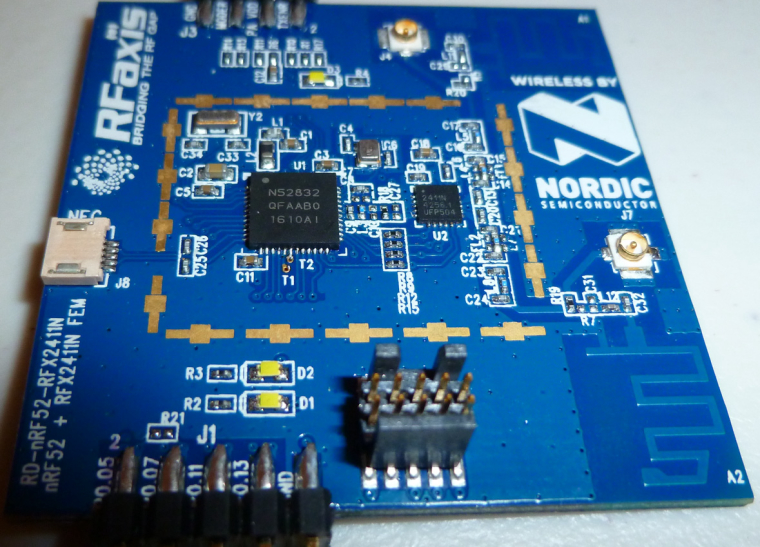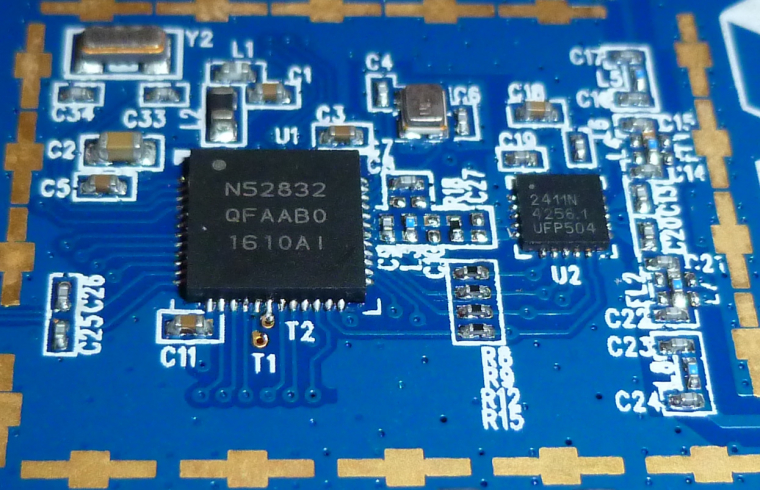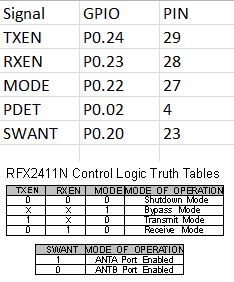nRF5 action!
-
@NeverDie Are you talking about MYS or in general? Because, currently there are two completely different approaches to nrf-arduino. One is based on softdevice (or in broader terms, on SDK) while another works direcly with hardware.
For MYS, our only hope is d00616, if he doesn't do it, chances somebody will apapt 52840 to MYS are negligible.
Frankly, MYS don't need it, but that's just my opinion.@Toyman said in nRF5 Bluetooth action!:
For MYS, our only hope is d00616, if he doesn't do it, chances somebody will apapt 52840 to MYS are negligible.
Please don't be so pessimistic. I expect some very small changes to MySensors to support the NRF52840 platform when arduino-nrf5 is ported to the new NRF5 MCU generation. When arduino-nrf5 supports the NRF52840 platform, I do some tests with the 840DK, I already have.
Looking back to the NRF52832, I think in 6-9 month we can buy NRF52840 modules with production ready chips. I think there is no reason for panic.
-
@Toyman
D00616's explanation increases my optimism considerably because: the people doing the NRF-arduino port care a lot about bluetooth. They'll want to see it through for that reason, because the 840 has much more bluetooth capabilities. Then, once they get that part done, like D00616 says, it will be ripe for porting to MYS. So really, all the interests are aligned. I don't think it will languish. At least, that's the narrative I'm going with. -
Received this today:

I thought it might have the same PA-LNA as the sky66112 (which also supports antenna diversity) used on the Fanstel, but the lettering suggests otherwise. -
Here's a better close-up of the chips themselves, which is easier to read:

-
The chip is now owned by Skyworks: http://www.skyworksinc.com/uploads/rfx/RFX2411N_DataSheet.pdf
-
The chip is now owned by Skyworks: http://www.skyworksinc.com/uploads/rfx/RFX2411N_DataSheet.pdf
-
@NeverDie As I may have mentioned before. This was a limited run of prototypes (100 total) designed by RF AXIS and built by Xungtong.. My understanding is that this device is being deemphasized by Skyworks in favor of the SKY661xx family..
@Jokgi
Do you happen to have the datasheet? The closest I've been able to find is: http://www.mouser.com/ds/2/472/rfaxis_RFX2411N Eval Board Summary and Technical N-952564.pdf
which isn't quite on-point, but I may have to make do with.I had thought it would somehow automagically select the better antenna for receiving, but it looks like it wants me to make that selection myself. So, this may work better with longer preambles I suppose, to give enough time to measure the RSSI on each and then decide.
-
@Jokgi
Do you happen to have the datasheet? The closest I've been able to find is: http://www.mouser.com/ds/2/472/rfaxis_RFX2411N Eval Board Summary and Technical N-952564.pdf
which isn't quite on-point, but I may have to make do with.I had thought it would somehow automagically select the better antenna for receiving, but it looks like it wants me to make that selection myself. So, this may work better with longer preambles I suppose, to give enough time to measure the RSSI on each and then decide.
-
@Jokgi The only datasheet I have states that it is confidential. Therefore I cannot share it. However if you contact Skyworks they may be able to get you a copy. At the time I received it one needed to fill out a form on RF Axis site and then the file would be sent. Are there any particular parameters you are interested in?
-
@Jokgi The only datasheet I have states that it is confidential. Therefore I cannot share it. However if you contact Skyworks they may be able to get you a copy. At the time I received it one needed to fill out a form on RF Axis site and then the file would be sent. Are there any particular parameters you are interested in?
Just which pins on the nRF52832 are connected to which control pins on the RF Front End. I just now checked with a continuity meter, and it looks like none of them are. So, it would appear that I'll need to wire the pin connections external to the PCB, which is weird, but maybe that's just how it is.
-
I agree with @d00616 points above.
And, sure bluetooth would be nice for interacting or debugging.In my opinion, maybe I'm wrong, for my network, I would prefer MySensors NRF ESB, in general.
- "more secure" than bluetooth. "harder" to access Mysensors ESB than bluetooth for example, plus some security issue that can happen with bluetooth, phones..
- more devices in a network
@scalz said in nRF5 Bluetooth action!:
In my opinion, maybe I'm wrong, for my network, I would prefer MySensors NRF ESB, in general.
- more devices in a network
Not with bluetooth mesh, you can have thousands of nodes ;)
-
Just which pins on the nRF52832 are connected to which control pins on the RF Front End. I just now checked with a continuity meter, and it looks like none of them are. So, it would appear that I'll need to wire the pin connections external to the PCB, which is weird, but maybe that's just how it is.
@NeverDie Hello, If you are referring to that Prototype Board with the Nordic logo on it then it was being controlled by GPIO and by the Bluetooth Low Energy stack (Softdevice) You can read more about it here.. https://devzone.nordicsemi.com/blogs/831/palna-support-in-s132/.
As I mentioned before. there is no good way to control the PA in a proprietary mode, only when using BLE. Regardless, I have asked if it is ok to share the schematic that relates to that PA board and I will let you all know. And about the question about antenna switching. This was never implemented in the Softdevice. Any antenna switching would need to be done in the application.
See if this chart helps.
-
@scalz said in nRF5 Bluetooth action!:
In my opinion, maybe I'm wrong, for my network, I would prefer MySensors NRF ESB, in general.
- more devices in a network
Not with bluetooth mesh, you can have thousands of nodes ;)
@Nca78 said in nRF5 Bluetooth action!:
Not with bluetooth mesh, you can have thousands of nodes ;)
not without some latency :)
but I agree, I forgot this new mode :+1:
I just prefer to keep my nodes "hidden" for security. so no BLE network for me. I will just have some restricted access to it I think.. -
@NeverDie Hello, If you are referring to that Prototype Board with the Nordic logo on it then it was being controlled by GPIO and by the Bluetooth Low Energy stack (Softdevice) You can read more about it here.. https://devzone.nordicsemi.com/blogs/831/palna-support-in-s132/.
As I mentioned before. there is no good way to control the PA in a proprietary mode, only when using BLE. Regardless, I have asked if it is ok to share the schematic that relates to that PA board and I will let you all know. And about the question about antenna switching. This was never implemented in the Softdevice. Any antenna switching would need to be done in the application.
See if this chart helps.
-
-
I just noticed a very clever thing that Fanstel did: their nRF52 modules all have the same land pattern and pinout. That means you can upgrade from a regular nRF52832 to a power amplified version, or even an NRF52840 (when they become available), by just dropping the upgrade module into the same position on the PCB. i.e. you can run all the different modules from the same PCB design. Pretty cool. I like it. :)
-
I just noticed a very clever thing that Fanstel did: their nRF52 modules all have the same land pattern and pinout. That means you can upgrade from a regular nRF52832 to a power amplified version, or even an NRF52840 (when they become available), by just dropping the upgrade module into the same position on the PCB. i.e. you can run all the different modules from the same PCB design. Pretty cool. I like it. :)
-
@NeverDie but how will you spend all the time you save by not having to create new boards all the time? ;-)
@mfalkvidd said in nRF5 Bluetooth action!:
@NeverDie but how will you spend all the time you save by not having to create new boards all the time? ;-)
Yeah, not just that, but also not having to waste all that time waiting for each new board to come back from the fab. :)
-
@Jokgi
Do you happen to have the datasheet? The closest I've been able to find is: http://www.mouser.com/ds/2/472/rfaxis_RFX2411N Eval Board Summary and Technical N-952564.pdf
which isn't quite on-point, but I may have to make do with.I had thought it would somehow automagically select the better antenna for receiving, but it looks like it wants me to make that selection myself. So, this may work better with longer preambles I suppose, to give enough time to measure the RSSI on each and then decide.
@NeverDie said in nRF5 Bluetooth action!:
I had thought it would somehow automagically select the better antenna for receiving, but it looks like it wants me to make that selection myself. So, this may work better with longer preambles I suppose, to give enough time to measure the RSSI on each and then decide.
I suppose an easy solution would be to have a remote node send repeated packets, and I just program the RFAxis to toggle between its two antennas after allowing sufficient dwell time per antenna. That way it's more likely to receive at least one of the packets.
All in all, though, I think maybe having two separate radio receivers (since they're cheap anyway) for a gateway is probably better than having one radio receiver, with the burden on the firmware to select which antenna to receive on.
Any thoughts on this?
-
@NeverDie 0_1508367805179_RD-nRF52-RFX2411N-REV2.zip Hello All -- For your viewing enjoyment. The Schematic and layout files for that nRF52840 and RFX2411n board you have. (If it is version 2 which did have the big Nordic logo on it. )
I think you may know this already but this bears repeating. This is not a Nordic board. Nordic Semiconductor's tech support will probably not know anything about this board. Also there is a difference between the RFX2411 and the nRF2411N. (N for Nordic) It is not the same device.
